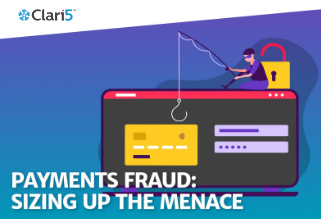 Technology solutions and services leader Magnus Corporation Ltd. recently announced that it has inked a strategic partnership with CustomerXPs for taking their acclaimed real-time EFCRM product to Bangladesh banks. The companies will work together on providing banks with extreme real-time intelligence for preventing fraud and money laundering attempts. Read More
Technology solutions and services leader Magnus Corporation Ltd. recently announced that it has inked a strategic partnership with CustomerXPs for taking their acclaimed real-time EFCRM product to Bangladesh banks. The companies will work together on providing banks with extreme real-time intelligence for preventing fraud and money laundering attempts. Read More
Month: July 2019
August 2019 Issue
DSCI Best Practices Meet 2019: Security at Scale
DSCI Best Practices Meet 2019: Security at Scale
25 July, 2019
Bangalore, India
DSCI’s recently concluded 11th Best Practices Meet (BPM) conference featured deep-dive deliberations on ‘Security at Scale’. The two-day conference focused on building capacities in security technologies, data protection on cloud, next-generation network security, malware analysis and APT defense, digital investigation, and advanced forensics. Rivi Varghese, Founder & CEO, CustomerXPs, addressed the plenary session on ‘Firefighting Payment Frauds’, where he spoke about how banks can assuage transaction risk and augment the payment experience.
DSCI’s Best Practices Meets are cybersecurity-focused conferences that see active participation from core technologists, practitioners, and users of security technologies.
Payments Fraud: Sizing up the Menace
Payments fraud is expected to top $22 bn this year. Here’s a quick look at the trends and factors driving the menace.

Threat Beyond Boundaries: Curbing Cross-Border Payments Fraud
Threat Beyond Boundaries: Curbing Cross-Border Payments Fraud

Money transfers are one of the most universal cash flow methods. Compared to other cross-border capital flows such as foreign direct investment or official development assistance, cross-border payments form an enormous chunk of transnational cash flow. In fact, the global payments revenue is expected to become a $2 trillion business by 2020.
Money transfer platforms have monetized the exponential growth of internet and mobile technologies and provide flexible and efficient money transfer options to individual and corporate customers who don’t have access to traditional banking or credit options. Given that money is often transferred overseas, cross border payment facilitates a process that was traditionally performed by specific agents or banks.
However, the boon has not been without a bane – the risk of fraud.
Transnational payments expose large financial institutions with global workforce and customer base to a myriad of risks. Fraudsters have been quick to capitalize on the rapid adoption of money transfer technology, exploiting systemic vulnerabilities. Without an iron-clad fraud protection, cross border payments stand to be impacted severely by fraud breaches.
Mergers and acquisitions have also been transforming the global payments landscape over time. For instance, there has been the creation of megabanks such as merger of Bank of America and NationsBank, as well as JP Morgan Chase combining Chase Manhattan Bank, Manufacturers Hanover Bank, Morgan Guaranty Trust and Bank One. In a scale-driven, technology-intensive business such as payments, the emergence of financial monoliths also brings in challenges of a different kind.
Large international banks operate their own internal global payment networks. Through these, they route payments to destinations in different countries. Such internal systems do not always differentiate between domestic and cross-border payments as these flows are within the bank.
Consolidations in the banking sector, both globally and in domestic markets, impacts payment systems. Increased concentration of payment flows has significant credit, liquidity, as well as fraud risk implications.
Global e-commerce is another factor. Nearly half of all e-commerce transactions transcend national boundaries and is the fastest-growing sector in retail. And with the growth of online merchant activity and risk from stolen identities and payment credentials, dubious business entities, cross-border payments are more likely to be suspected as fraudulent transactions.
For merchants expanding their online presence overseas, enabling locally-preferred alternative payment methods and connecting to local acquirers can be a critical success factor. However, without dovetailing a solid fraud management strategy with the payments strategy, insulating cross-border remittances from fraud can be a challenge.
While opening up transactions to new geographies securely, financial institutions must look for providers and merchants who use digital identity-based user verification and assessment solutions to get accurate data on the risks associated with all the entities they transact with.
As payments risks continue to pose a threat, it is imperative that financial institutions use certain technology best practices to insulate themselves from fraud.
Some of the measures that financial institutions can implement have as part of their overall fraud risk and compliance management framework for inward & outward cross-border payments are –
- Advanced watch list screening capabilities to screen various parties against sanctions lists, internal lists & any other custom lists (including remitter, beneficiary, participating institutions).
- KYC due diligence with frequent, periodic customer risk rating
- Intelligent real-time, cross channel transaction monitoring with pre-packaged AML / fraud scenarios and detection models that help identify unusual transaction volumes, risky jurisdictions, mule accounts, transactions inconsistent with customer profile, customers with past STR/SAR marked history and quick drainage after inward remittance.
- Machine learning driven behavioral analytics model to build usual transaction profile (across multiple dimensions such as transaction types, beneficiaries, merchants, transaction purpose)to detect anomalous transaction patterns against customer’s own past transaction history and against peer group.
- Integrated case management fora 360-degree customer view, with built-in customizable work flows and alert assignment policies to accelerate alert investigations and empower fraud investigators to focus on high priority alerts
- Leverage RPA capabilities to eliminate manual searches for internal and third-party data
- Automated reporting capability to generate regulatory filing reports to FIU agency with minimal human inputs
- Entity link analysis tool to discover hidden relationships, based on demographic profiles (to detect seemingly disparate but interrelated parties) and transaction patterns (to detect schemes such as structuring and mule account transfers)
In a heavily regulated industry, where relationships are built on trust, consistent adherence to high security levels and regional financial regulations is paramount. Leveraging advanced analytics, artificial intelligence and machine learning models at an enterprise-wide level, can help financial institutions detect cross-border payments fraud in real-time, reduce false positives and run more efficient investigations.
References
- Remittances, The Flywheel of The Global Economy
- Global Payments: A Dynamic Industry Continues to Break New Ground
- Understanding Cross-Border Remittances
- Inefficiencies of Cross-Border Payments
- Cross-Border eCommerce Expansion: A Fraud Perspective











